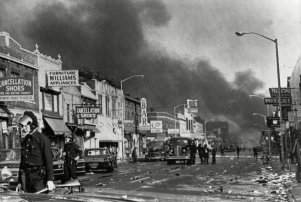
So much to hope, so much to fear from Kathryn Bigelow’s Detroit — at least, that’s how many of us who grew up in and around Detroit feel about the film Bigelow is directing, based on a script by collaborator Mark Boal, about the 1967 riot. When the trailer dropped earlier this month, a shudder ran through some in the Motor City.
“Here, people are so used to negative portrayals, and given the subject matter they’re just numb to another one like all the others,” offered one film-savvy Detroiter—a major fan of both Boal and Bigelow—in a private email. But, the same correspondent noted, a perhaps slightly overheated trailer, with heavy emphasis on police brutality in the Algiers Motel killings that occurred mid-way through the July unrest, doesn’t mean the filmmakers won’t have captured the combined horror and heartbreak of the Detroit uprising in a drama set for release by Annapurna Pictures on August 4.
Soon enough, the film will speak for itself. Already, though, Detroiters have been using film to examine not just the five-day riot, but also about the lost era—and the possibilities—that burned with it. Largely unnoticed here, March 30 brought the world premiere in Detroit of a documentary 12th And Clairmount, that tells a story of the uprising and its precedents largely through the use of “found footage.” Produced by the Detroit Free Press and others, the film does what even the most skillfully crafted drama would hard-pressed to match. That is, it re-captures some of the ease and even amity that sometimes prevailed in what was, after all, a still hopeful time in Detroit.
“The footage donated by the white people is just like footage donated by the black people,” said Bill McGraw, a former Free Press reporter who worked on the film, in describing it to a Free Press interviewer. “Everyone’s dancing in the basement, doing the same sort of dances, kids are riding their old Stingray bikes with their banana seats, playing Wiffle ball in the street or in front of their house. It shows how life was going on often the same for people even though they were living very separate lives.”
REX/Shutterstock
Obviously, the riot didn’t come from nowhere. There was deep racial injustice and a powerful reaction. “You can understand that there would be a lot of anger building up, and it exploded,” said Larry Bohner, who contributed footage to 12th And Clairmount, to the same Free Press interviewer.
That part, to judge from the red-hot Detroit trailer, is well-represented by Boal and Bigelow. But harder to recall are those better moments on the racial fault line, as when you could find yourself standing with a couple of Temptations—who were just off the stage in Cobo Arena, probably in late 1966, if I remember correctly—as they marveled at the still-novel long-hairs in a local psychedelic band, the Scot Richard Case, who were performing in the banquet-hall next door.
Through the mid-1960s, 12th And Clairmount reminds us, the city was still alive. In 1967, that Detroit promo says, the gentler part died.
